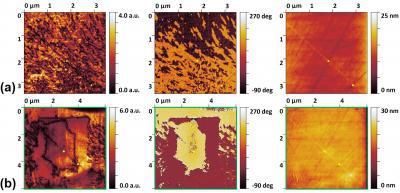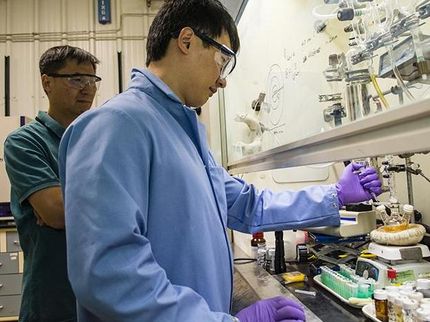Laser-fabricated crystals in glass are ferroelectric
Laser-generated crystals confined in glass retain controllable ferroelectric properties
A team of researchers from Lehigh University, Oak Ridge National Laboratory, Lebanon Valley College and Corning Inc. has demonstrated, for the first time, that crystals manufactured by lasers within a glass matrix maintain full ferroelectric functionality.

Ferroelectric single-crystal-architecture-in-glass is a new class of metamaterials that would enable active integrated optics if the ferroelectric behavior is preserved within the confines of glass. We demonstrate using lithium niobate crystals fabricated in lithium niobosilicate glass by femtosecond laser irradiation that not only such behavior is preserved, the ferroelectric domains can be engineered with a DC bias. A piezoresponse force microscope is used to characterize the piezoelectric and ferroelectric behavior. The piezoresponse correlates with the orientation of the crystal lattice as expected for unconfined crystal, and a complex micro- and nano-scale ferroelectric domain structure of the as-grown crystals is revealed.
Keith Veenhuizen, Sean McAnany, Rama Vasudevan, Daniel Nolan, Bruce Aitken, Stephen Jesse, Sergei V. Kalinin, Himanshu Jain and Volkmar Dierolf
"This includes the ability to uniformly orient and reverse orient the ferroelectric domains with an electric field despite the fact that the crystal is strongly confined by the surrounding glass," says Volkmar Dierolf, Chair of Lehigh University's Department of Physics and one of the scientists who worked on the experiments that resulted in these findings.
Dierolf, who holds a joint appointment with Lehigh's Department of Materials Science and Engineering part of the P.C. Rossin College of Engineering and Applied Science, is co-Principal Investigator on a National Science Foundation (NSF)-funded project, Crystal in Glass, along with Principal Investigator Himanshu Jain, Diamond Distinguished Chair of Lehigh's Department of Materials Science and Engineering. The group has become a world leader in producing single crystals in glass by localized laser irradiation.
The team conducted the first detailed examination of the piezoelectric and ferroelectric properties of laser induced crystals confined in glass. They found that the as-grown crystals possess a complex ferroelectric domain structure that can be manipulated via the application of a DC bias.
"The findings open up the possibility of a new collection of optical devices that use fully functional laser-fabricated crystals in glass which rely on the precise control of the ferroelectric domain structure of the crystal," said Keith Veenhuizen, currently Assistant Professor, Department of Physics at Lebanon Valley College and the lead author of the paper, which builds on the work he did as a graduate student at Lehigh.
Applications for such technology include use in modern fiber optic technology used for data transmission.
"Being able to embed such functional single crystal architectures within a glass enables high efficiency coupling to existing glass fiber networks," says Dierolf. "Such low loss links?that maximize performance?are of particular importance for future quantum information transfer system that are projected to take over the current schemes for optical communication," adds Dierolf.
Original publication
Original publication
Veenhuizen, Keith and McAnany, Sean and Vasudevan, Rama and Nolan, Daniel and Aitken, Bruce and Jesse, Stephen and Kalinin, Sergei V. and Jain, Himanshu and Dierolf, Volkmar; "Ferroelectric domain engineering of lithium niobate single crystal confined in glass"; MRS Communications; 2019
Organizations
Other news from the department science

Get the chemical industry in your inbox
By submitting this form you agree that LUMITOS AG will send you the newsletter(s) selected above by email. Your data will not be passed on to third parties. Your data will be stored and processed in accordance with our data protection regulations. LUMITOS may contact you by email for the purpose of advertising or market and opinion surveys. You can revoke your consent at any time without giving reasons to LUMITOS AG, Ernst-Augustin-Str. 2, 12489 Berlin, Germany or by e-mail at revoke@lumitos.com with effect for the future. In addition, each email contains a link to unsubscribe from the corresponding newsletter.



























































